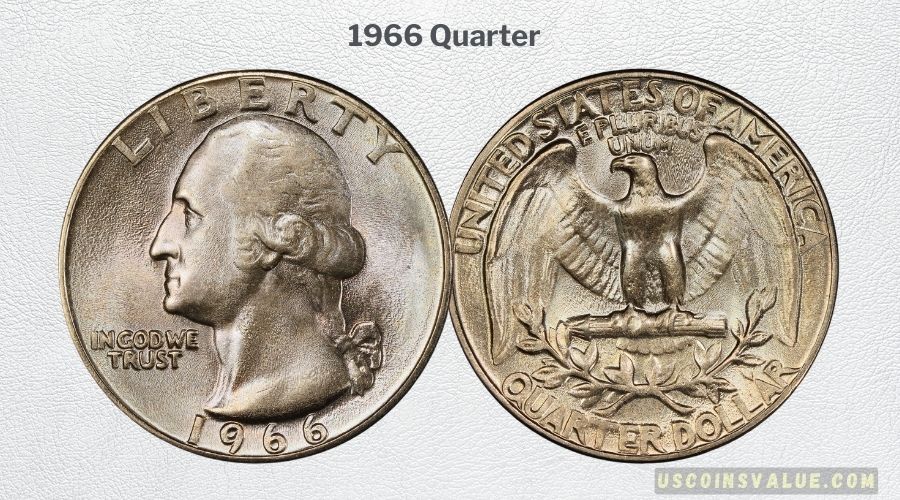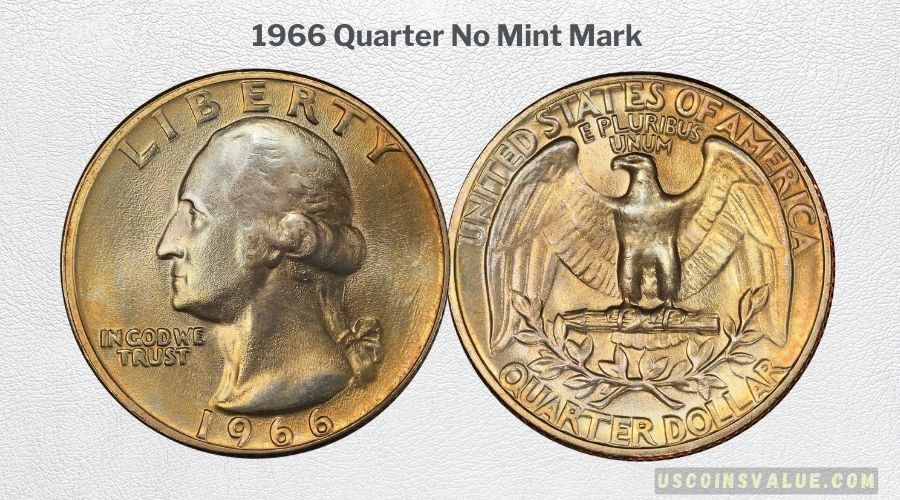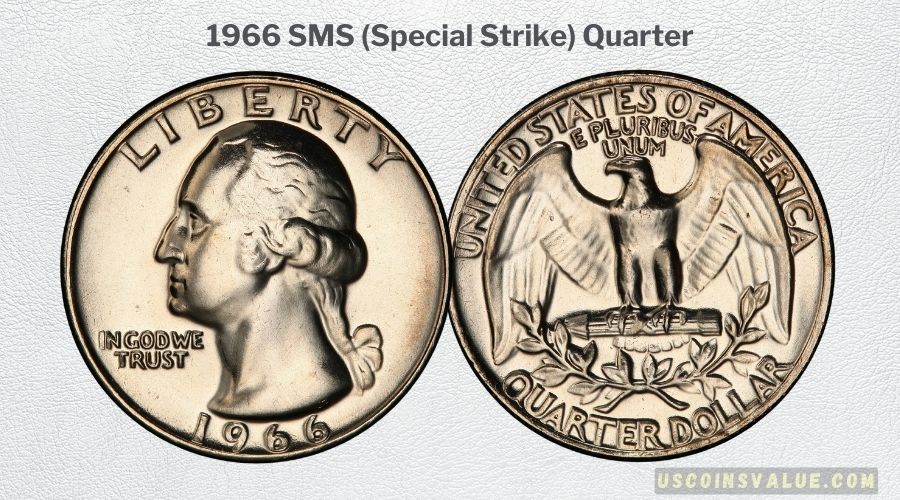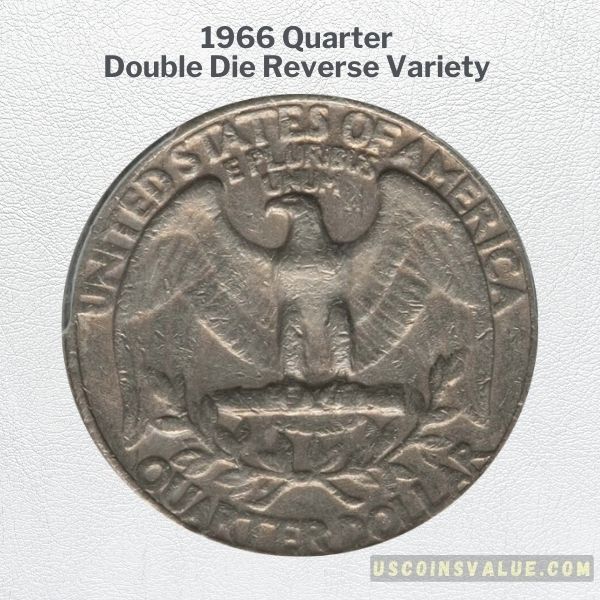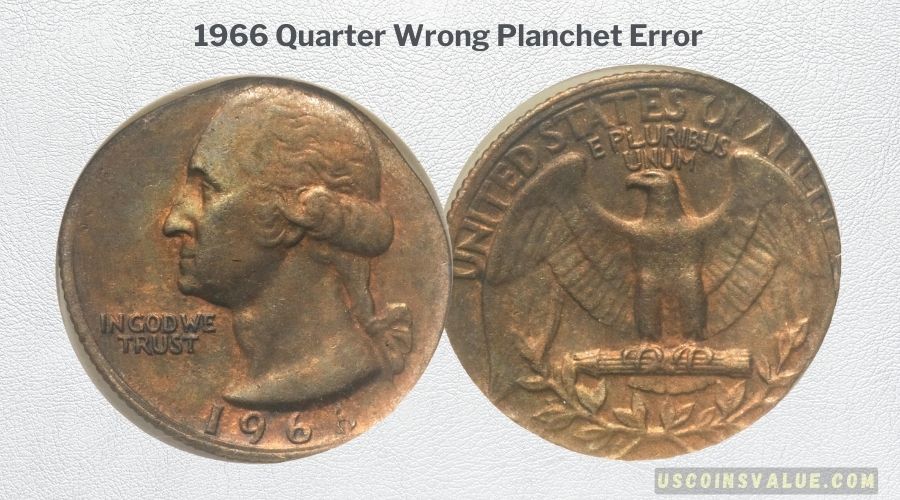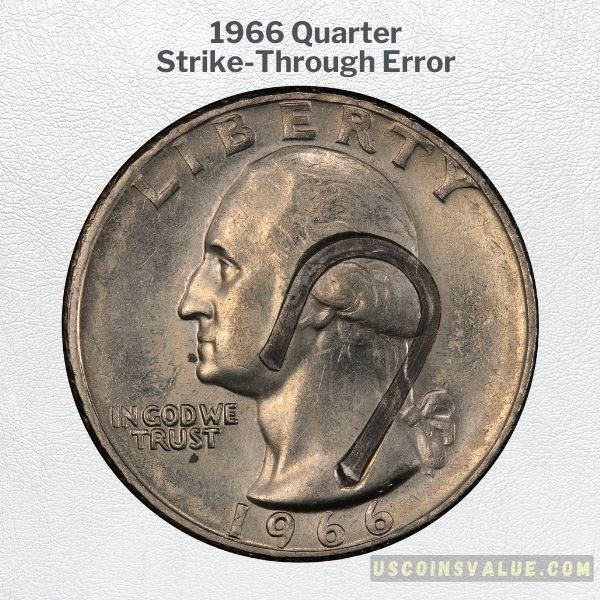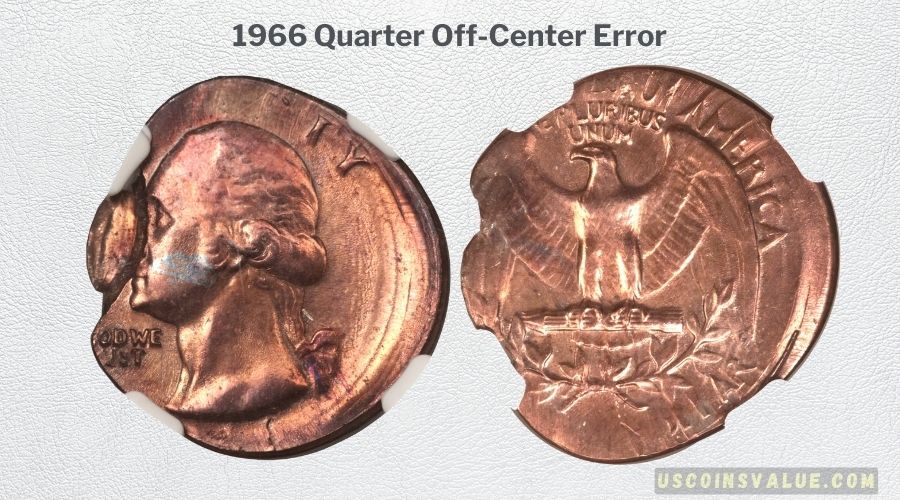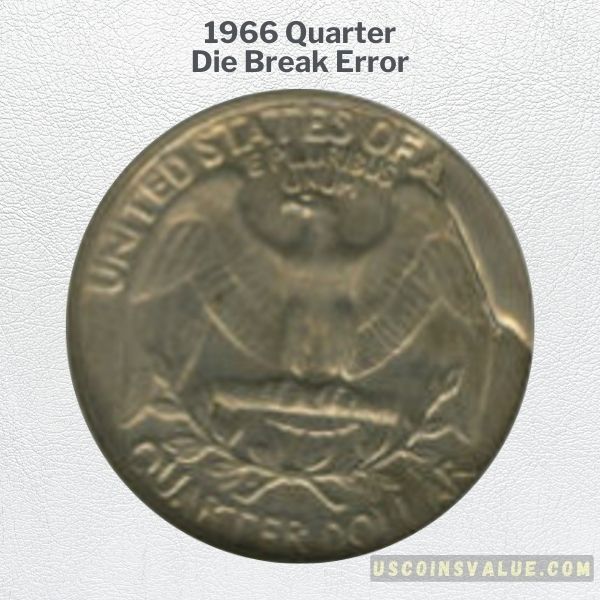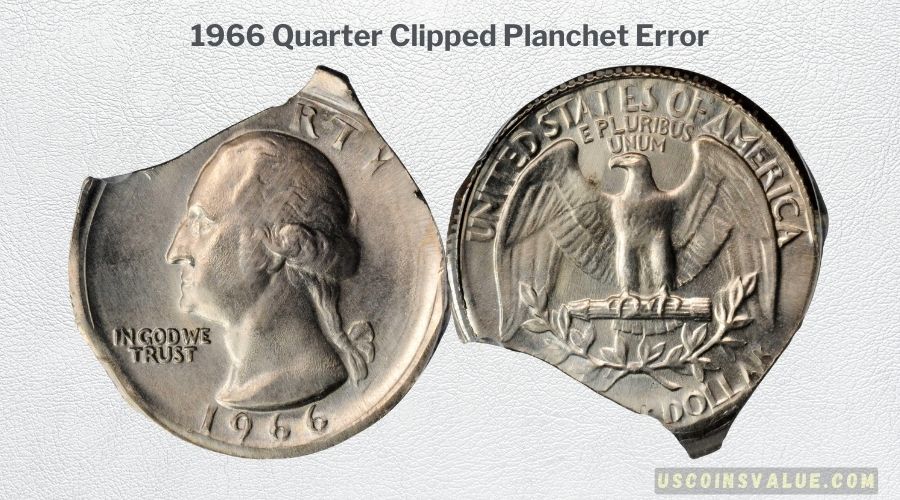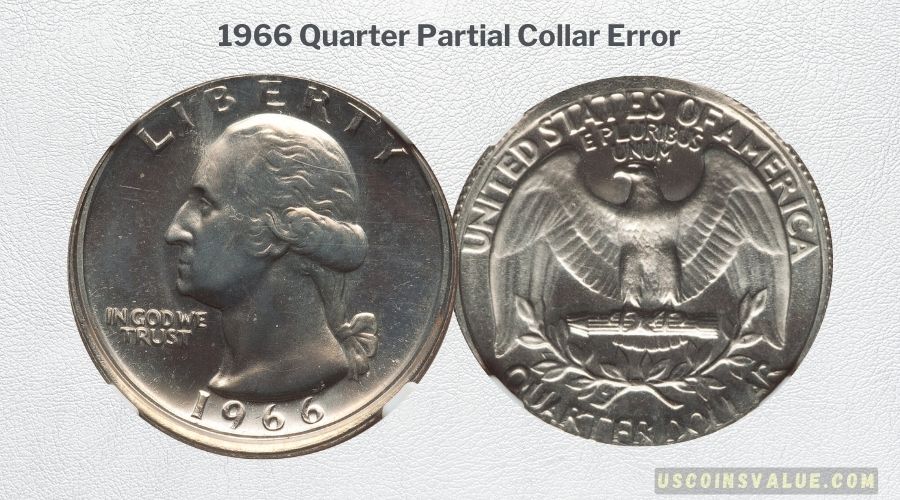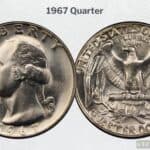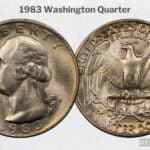1966 quarters are not the most valuable coins, but they can still be worth a decent amount depending on their condition and striking.
The most valuable 1966 quarter with the highest sale record is the MS68+ coin, which sold for $21,000 in 2023 at Heritage Auctions.
The quarters are valued depending on the following:
- Highest Grades (MS68+) of Regular Strike 1966 quarters are the most valuable. Worth up to $21,000 in MS68+ grades.
- 1966 SMS quarters are Special Strike quarters rarely made in any year, making this variety valuable among collectors. Worth up to $4,000 in SP68 grades.
- Unique Errors like the DDR increase their value by $50 to over $1,000 per coin.
While its face value remains a mere 25 cents, certain varieties and conditions can increase its worth to remarkable heights. Here is a deep dive into the most valuable 1966 quarters, their error, and historical significance.
1966 Washington Quarter Value Summary
Below is the 1966 quarter value chart, arranged based on grade condition and strike:
| 1966 Quarter and Coin Grade | 1966 No Mint Mark Quarter (MS) | 1966 SMS (Special Strike) Quarter (MS) |
| 60 | $1 – $2 | $3 – $12 |
| 61 | $2 – $3 | $4 – $16 |
| 62 | $3 – $4 | $5 – $22 |
| 63 | $5 – $8 | $10 – $45 |
| 64 | $10 – $12 | $12 – $100 |
| 65 | $16 – $20 | $14 – $240 |
| 66 | $30 – $70 | $16 – $775 |
| 67 | $285 – $1,350 | $26 – $3,900 |
| 68 | $9,500 – $21,000 | $85 – $6,500 |
| 69 | N/A | N/A |
| 70 | N/A | N/A |
Note:
- The N/A in columns without a price guide does not mean the coins are rare. Instead, it shows there isn’t enough data or coins to publish an average price estimate.
- The grades (60 – 70) represent the particular coin’s grading prefix, i.e., MS60-MS70 for Regular Strike coins and SP60-SP70 for SMS (Special Strike) quarters.
1966 Washington Quarter Background
The 1966 Quarters are part of the Washington Quarter series, specifically the Type 2 Clad quarters made between 1965 and 1998.
These coins came about due to the rising prices of silver at the time. Quarters before 1965 were made primarily of silver, but the production was becoming expensive, with the mintage cost exceeding the quarters’ face value.
During the Coinage Act of 1965, silver was eliminated from circulating U.S. dimes and quarters. Instead, the U.S. Mint would produce quarters with a clad composition of copper-nickel over a pure copper core from 1965 onwards.
Therefore the 1966 quarter comprises 75% copper and 25% nickel over a pure copper core – making up a total composition of 91.67% copper and 8.33% nickel.
Unlike other coins at the time that were produced in all three U.S. Mints, the 1966 Quarter was only minted in Philadelphia and San Francisco with just two types: the 1966 No Mint Mark and the 1966 SMS Quarter.
- 1966 No Mint Mark Quarter – Made in Philadelphia (P). The quarters do not feature the ‘P’ mint mark. They are Regular Strike coins made for circulation and used in everyday commerce.
- 1966 Special Strike (SMS) – Made in San Francisco. These quarters are uncirculated coins made for numismatic purposes and sold to collectors. They are not Proof coins but feature a nice, smooth, satin-like appearance.
Neither of the two coins has the ‘P’ or ‘S’ mint mark.
Here is a quick summary of the coin’s mintage and metal composition:
| Coins | Mint | Total Mintage | Metal Composition |
| 1966 No Mint Mark Quarters | Philadelphia | 821,101,500 | 75% Copper, 25% Nickel over a pure copper center |
| 1966 SMS Quarters | San Francisco | 2,261,583 | 75% Copper, 25% Nickel over a pure copper center |
Other features include:
- Obverse (heads) design: Features George Washington’s portrait facing the left side, designed by John Flanagan.
- Reverse (tails) design: Depicts a bald eagle perched on a bundle of arrows, with its wings outstretched. Two olive branches hang below the eagle.
- Weight: 5.67 grams
- Diameter: 24.30 millimeters
- Edge: Reeded
Most Valuable 1966 Quarters
With a mintage of over 820 million, the 1966 quarters are not rare coins. However, they become scarce once you go up the grades.
1. Coin Condition – Grades
The Sheldon Scale, a universal grading system for coins, provides a standardized approach to assessing the overall quality and preservation of a coin.
For the 1966 quarters, the Sheldon Scale grades range from Poor-1 (the lowest grade) to Mint State 70 (the highest grade). The higher the grade, the better preserved the coin’s original features, such as its sharpness of detail, luster, and freedom from blemishes.
To illustrate the impact of grade on value, consider a 1966 quarter in Extremely Fine-40 (XF-40) condition. This coin exhibits moderate wear, with noticeable surface imperfections, but still retains some of its original design elements. PCGS (Professional Coin Grading Service) states it is worth $0.85 or less.
In contrast, a 1966 quarter in Mint State-65 (MS65) condition showcases exceptional preservation, with its sharp details, vibrant luster, and minimal signs of wear, hence commanding a significantly higher price. According to PCGS, it is worth $16 or more.
The 1966 Special Strike (SMS) quarters tell another story, albeit similar.
The U.S. Mint introduced the Special Mint Set (SMS) in 1965 and produced the sets for each coin each year till 1967. SMS Coins were made because the Mint did not make any Proof coins or uncirculated sets during this period, opting to focus on circulating coins.
SMS coins would be made in special finishes but not as fine as Proof coins so as to dispense only a little labor from circulating coins.
SMS coins boast a higher level of craftsmanship and attention to detail than Regular Strike Coins. They are typically struck using specially prepared dies and planchets, resulting in a sharper strike, cleaner surfaces, and a brighter luster.
They were also minted in limited quantities, which added to their collectability.
According to the Sheldon Scale, SMS coins are typically graded using SP (Specimen Strike) prefixes. SP grades are reserved for coins that exhibit the highest level of preservation and are considered to be true collector’s pieces. This means it is not rare to see SMS coins with MS grades.
SP70 is the highest grade, and SP60-SP70 represents SMS coins with the highest level of preservation.
Another quality differentiator in Specimen Strike coins is DCAM, CAM and SP.
DCAM (Deep Cameo) is the highest level of quality for specimen strike coins. These coins exhibit exceptionally striking, sharp details, clean surfaces and deep frosting. The frosting is so deep that it appears to be recessed into the coin’s surface.
CAM (Cameo) is the second-highest level of quality for specimen strike coins. These coins also exhibit frosting, but it is not as deep as the frosting on DCAM coins.
SP (Specimen Strike) is the lowest grade in the bunch, referring to coins that were struck with extra care and attention to detail. They are typically well-struck, but the details are not as sharp as those on DCAM or CAM coins.
DCAM coins are more valuable than the two, with SP being the least valuable.
2. Errors & Varieties
There are a few notable errors in the 1966 quarters like DDR (Double Die Reverse) variety, Wrong Planchet, and Off-Center errors.
Mint errors refer to mistakes made during the coin production process, resulting in coins with variations in design, shape, weight or composition. These variations may occur due to problems with the dies, planchets or the striking process.
Some mint errors are rare and valuable, like “transitional errors,” while others are more common, like “die chips” and “lamination errors,” and do not affect the coin’s value significantly.
1966 Quarter Value
Here is the value of each 1966 quarter based on the mint categories:
1. 1966 Quarter No Mint Mark Value
As of November 2023, the NGC (Numismatic Guaranty Company) price guide had evaluated the 1966 no mint mark quarter, pricing it at $0.30 – $0.85 in common circulated condition, which includes coins below AU-58. In the rarest uncirculated conditions (MS68), the coins sell for as high as $5,750.
According to the USA Coin Book, the coin is worth $8.07 or more in Brilliant Uncirculated conditions (MS65) and has a low melt value of $0.0517.
A look at PCGS shows the coin’s value at less than $8 in MS63 or below. MS64 is worth $10, MS65 $16, and MS66 at $30.
The prices become more lucrative from MS67, where you can sell one for $285 while an MS67+ coin goes for a whopping $1,350.
Please keep in mind that the coins at this grade are rarer to find, and even rarer at MS68 and MS68+, which are the highest known grades, worth $9,500 and $21,000, respectively.
The most common MS grades for the 1966 quarters are between MS60 – MS63. MS64 – MS66 are fewer but readily available in the open market, where you can buy them for relatively cheap (below $40).
Historical auction records for the 1966 quarter no mint mark:
| Grade | Price | Firm | Sale Date |
| MS68+ | $21,000 | Heritage Auctions | 2023 |
| MS68 | $11,750 | Legend Rare Coin Auctions | 2019 |
| MS68 | $7,344 | Legend Rare Coin Auctions | 2022 |
| MS68 | $5,760 | Heritage Auctions | 2023 |
| MS68 | $4,440 | Heritage Auctions | 2017 |
2. 1966 SMS (Special Strike) Quarter Value
These quarters’ design details and characteristics are ranked between Proof and Regular strike coins. While not as valuable as regular strike quarters, 1966 SMS quarters can still be worth more than $50,000 in SP68 DCAM grades.
The lowest-priced are SP coins, valued at less than $85 in the best grades (SP68).
DCAM are the most valuable, worth $12 in SP60, $20 in SP62, more than $150 in SP65, more than $2,500 in SP67, and up to $6,500 in SP68.
Historical auction records for the 1966 SMS quarter no mint mark:
| Grade | Price | Firm | Sale Date |
| SP68/MS68CAM | $4,112.50 | Heritage Auctions | 2014 |
| MS67 DCAM | $3,737.50 | Heritage Auctions | 2006 |
| PR68/MS68CAM | $2,875 | Heritage Auctions | 2005 |
| PR68/MS68CAM | $2,070 | Heritage Auctions | 2004 |
| SP67/MS67DCAM | $1,840 | Heritage Auctions | 2012 |
Valuable 1966 Quarter Errors List
There are very few errors in the 1966 quarters with the most notable one being the Double Die Reverse Variety. Other minor errors have also been noted, including lamination errors, but these do not add much value to the coin; in fact, in some cases, they can diminish the value of the coin.
Below are the few valuable 1966 quarter errors to look out for:
1. Double Die Reverse (DDR)
DDR is a variety rather than an error since it might have been intentionally introduced due to changes in production.
Double Die Reverse is a change that happens when a die is imprinted with multiple impressions of design elements instead of a single impression. This results in coins that have elements that look doubled.
The 1966 quarter DDR variety (FS-801) with this error include the XF45 graded coin that sold for $920 in 2012 at Heritage Auctions and another VF Details coin sold for $144 in 2018.
2. Wrong Planchet Error
A wrong planchet error happens when the 1966 quarter is struck on a planchet meant for a different coin.
A coin with this error will have 1966 quarters’ design features, but the metal composition and weight of the wrong planchet used. It will also have an irregular shape since different planchets come in different sizes.
Some of the best sellers with this error include:
- 1966 Quarter “Struck on a Cent Planchet” sold for $977.50 in 2012.
- 1966 Quarter “Struck on a 5C Planchet” sold for $107 at Great Collections in 2014, another MS65 coin with a similar error sold for $312 at Stack’s Bowers in 2020.
- MS61 graded 1966 Quarter “Struck on a Copper-Nickel Clad Dime Planchet, sold for $188 in 2014 at Stack’s Bowers.
3. Strike-Through Error
The Strike Through error happens when foreign materials or inclusions fall between the dies and planchet. This causes the material to leave an impression on the coin’s surface after its struck.
A quick look at eBay will show you a few of these error coins for about $14 or less.
Below is an example that sold for $1,080 in 2023. It is an AU58 coin with a “Struck-In & Retained Wire Obverse, Magnetic”.
This is a one-of-a-kind error since, unlike other strike-through errors, in this case, the coin shows a wire that was struck into the front side of the quarter and got retained on it. It is also magnetic due to the iron content of the wire.
4. Off-Center Error
Off-center errors occur when coin dies do not align correctly with the planchet during production. As a result, a portion of the coin’s design is struck off-center. The degree of off-centering can vary from a slight misalignment to a severe one.
This MS62 coin has a “Struck 10% off center on a Cent Planchet With Obverse Indent” error and sold for $1,292.50 in 2013. In this case, we have multiple errors in one, a truly unique piece with some details of the coin missing and struck moderately off-center.
5. Die Break Error
A die break is an error that happens when a portion of the die used to produce a coin gets damaged, breaks, or fractures. This causes the final struck coin to have some irregular raised features on its surface.
An example is this $55 AU58 quarter that has been on auction since 2005, labeled “Reverse Die Break”. There is a huge die break on the reverse between 1 and 3 o’clock.
6. Clipped Planchet Error
A coin with a clipped planchet error looks like the image below. It is a coin made from an incomplete planchet that is fed into the coining press, where it is struck by the dies to create a coin.
The 1966 quarter shown above is an MS62 coin sold for $80 at Stacks’ Bowers.
7. Partial Collar Error
A collar is part of the press used in minting coins to shape and hold a coin’s edge when striking. A partial collar error happens when the collar is improperly aligned, leading to the creation of a coin that has part of its surface that did not fully form (usually thicker than the rest of the coin’s surface).
An example is the above MS67 coin that sold for $144 in 2021.
Conclusion
While 1966 quarters may not be the rarest or most valuable coins, their value can still range from a few cents to thousands of dollars, depending on their condition, errors, and striking.
For the highest pay, look out for SP68 and MS68 coins or higher. If you happen to find a DDR or Wrong Planchet 1966 quarter, then you can also be assured of more than a few hundred dollars. Collectors and enthusiasts should pay attention to these factors when considering the value of their 1966 quarters.

